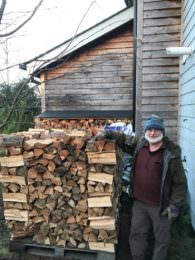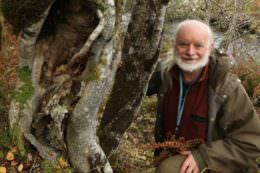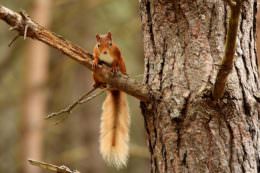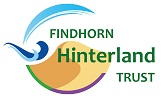How did you get so involved in nature and nature conservation?
 I have had a long history of developing a deep relationship with nature which I think really started in a serious way back when I travelled abroad. In 1972 when I was 18 I travelled in Europe and the following year I went to Canada where I spent time in Western Canada connecting with the Rocky Mountains, big forests and healthy landscapes full of species. That really touched me deeply. When I left university I decided to explore nature more and went back to Canada to live for a couple of years before travelling the whole length of South America including the Amazon, the Andes, Tierra del Fuego – you name it and I was there! That really opened my heart and was my preparation for coming to Findhorn.
I have had a long history of developing a deep relationship with nature which I think really started in a serious way back when I travelled abroad. In 1972 when I was 18 I travelled in Europe and the following year I went to Canada where I spent time in Western Canada connecting with the Rocky Mountains, big forests and healthy landscapes full of species. That really touched me deeply. When I left university I decided to explore nature more and went back to Canada to live for a couple of years before travelling the whole length of South America including the Amazon, the Andes, Tierra del Fuego – you name it and I was there! That really opened my heart and was my preparation for coming to Findhorn.
I came here through finding the Findhorn Garden Book in the most unlikely place of downtown New York in the heart of the urban jungle! I was really touched by the connection with the spirit of nature, particularly Dorothy Maclean’s work which really resonated with me. When I came to the community I lived at Cluny for many years where I started in the kitchen and then very quickly moved into the garden where I worked for four years. In the garden I learned that I could give back my care, my love and my attention to nature to help make it flourish, not just taking from it what I could receive and appreciate.
In 1979 I started to go out to Glen Affric in the Highlands of Scotland which was like a tiny bit of Canada here in Scotland. I began to visit there regularly and soon I started to feel the pain of the dying forests- I felt the trees were calling out for help. I was also inspired by visits here from Richard St Barbe Baker the Man of the Trees and other people like that who visited the community. These experiences led me to found Trees for Life which became the main chunk of my life’s work involving the restoration of the Caledonian Forest for 31 years.
Whilst carrying out lots of surveys, studies and identifying species in the forest I developed a great interest in biodiversity so when I got involved in the Findhorn Hinterland Trust I was able to bring that knowledge, background and care for natural ecosystems with me to my backyard where I live. My work now doesn’t involve long journeys and I can come here very quickly. I see an opportunity to help this land become more natural, more diverse and more abundant because when we inherited it, it was mostly an old pine plantation, bits of the former air force base and gorse scrub. There is a lot more diversity returning now through the work of FHT.
Tell us a little bit more about your work with the Findhorn Hinterland Trust
 My involvement is on two levels. One is that I am a trustee of the trust with the specific job title of Land Trustee. In that role I chair the Land Management subgroup which has an overview of the practical work on the land. The other is more specific – I have a strong interest in identifying the biodiversity that is here so I also do a lot of photography on the site and have commissioned, through the auspices of the trust, various biodiversity surveys. The latter has over the years involved inviting specialists to come to look at things like moths, spiders, true bugs and many other groups of organisms that inhabit this land. I am aware that there is still quite a list of different organisms to work through until we get a full picture of what is here.
My involvement is on two levels. One is that I am a trustee of the trust with the specific job title of Land Trustee. In that role I chair the Land Management subgroup which has an overview of the practical work on the land. The other is more specific – I have a strong interest in identifying the biodiversity that is here so I also do a lot of photography on the site and have commissioned, through the auspices of the trust, various biodiversity surveys. The latter has over the years involved inviting specialists to come to look at things like moths, spiders, true bugs and many other groups of organisms that inhabit this land. I am aware that there is still quite a list of different organisms to work through until we get a full picture of what is here.
How has this work helped with the recently set up Dune Restoration Project?
The biodiversity surveys that have been happening over the last few years have given us some very useful data that can be used to help promote and justify this project. For example we have found some rare fungi out there as well as other organisms such as special lichens. There are several of us that have a strong interest in biodiversity and we have a biodiversity day on the 1st of June coming up where we have people joining us with whom we hopefully will share our knowledge, experience and wisdom.
What is the future work of the trust? What is your vision?
For me I think the vision has two main parts to it. The first is to bring the land back to a state of greater health and diversity. That is a long term project because we have these old pine plantations some of which we are gradually naturalising. That is going to go on for at least a few decades and will enrich the habitat with a greater diversity of species. Then there is making sure that it is protected such as with the Dune Restoration Project which will help make sure the encroachment of gorse is halted and the rare dune habitat safeguarded.
 The other main aspect of it is about education – being an example to people, a source of knowledge, information and inspiration for both local people who live here, many of whom may not know so much about the area, and also for visitors that come be they on programmes that we run, school groups and others. We have the potential to establish a real solid pool of knowledge and depth of understanding that we can share with other people. That to me is really essential because that understanding is what the world needs now as we move into this time of rapid transition and major change on the planet. We have to reconnect with nature, understand our connectedness and the necessity of healthy, fully functioning ecosystems for the survival, not just of humans, but all life on the planet.
The other main aspect of it is about education – being an example to people, a source of knowledge, information and inspiration for both local people who live here, many of whom may not know so much about the area, and also for visitors that come be they on programmes that we run, school groups and others. We have the potential to establish a real solid pool of knowledge and depth of understanding that we can share with other people. That to me is really essential because that understanding is what the world needs now as we move into this time of rapid transition and major change on the planet. We have to reconnect with nature, understand our connectedness and the necessity of healthy, fully functioning ecosystems for the survival, not just of humans, but all life on the planet.
Is there anything else you would like to add?
I would just like to say for people reading this newsletter, to come and see for yourself, get in touch with us and come and visit the Hinterland. We can give you a tour or share some special things with you in one of our workshops or you can participate in our fun and rewarding work parties.
Interviewed by
Jonathan Caddy
FHT Chair
May 2024




Meet the Team – Alan Watson Featherstone.
How did you get so involved in nature and nature conservation?
I came here through finding the Findhorn Garden Book in the most unlikely place of downtown New York in the heart of the urban jungle! I was really touched by the connection with the spirit of nature, particularly Dorothy Maclean’s work which really resonated with me. When I came to the community I lived at Cluny for many years where I started in the kitchen and then very quickly moved into the garden where I worked for four years. In the garden I learned that I could give back my care, my love and my attention to nature to help make it flourish, not just taking from it what I could receive and appreciate.
In 1979 I started to go out to Glen Affric in the Highlands of Scotland which was like a tiny bit of Canada here in Scotland. I began to visit there regularly and soon I started to feel the pain of the dying forests- I felt the trees were calling out for help. I was also inspired by visits here from Richard St Barbe Baker the Man of the Trees and other people like that who visited the community. These experiences led me to found Trees for Life which became the main chunk of my life’s work involving the restoration of the Caledonian Forest for 31 years.
Whilst carrying out lots of surveys, studies and identifying species in the forest I developed a great interest in biodiversity so when I got involved in the Findhorn Hinterland Trust I was able to bring that knowledge, background and care for natural ecosystems with me to my backyard where I live. My work now doesn’t involve long journeys and I can come here very quickly. I see an opportunity to help this land become more natural, more diverse and more abundant because when we inherited it, it was mostly an old pine plantation, bits of the former air force base and gorse scrub. There is a lot more diversity returning now through the work of FHT.
Tell us a little bit more about your work with the Findhorn Hinterland Trust
How has this work helped with the recently set up Dune Restoration Project?
The biodiversity surveys that have been happening over the last few years have given us some very useful data that can be used to help promote and justify this project. For example we have found some rare fungi out there as well as other organisms such as special lichens. There are several of us that have a strong interest in biodiversity and we have a biodiversity day on the 1st of June coming up where we have people joining us with whom we hopefully will share our knowledge, experience and wisdom.
What is the future work of the trust? What is your vision?
For me I think the vision has two main parts to it. The first is to bring the land back to a state of greater health and diversity. That is a long term project because we have these old pine plantations some of which we are gradually naturalising. That is going to go on for at least a few decades and will enrich the habitat with a greater diversity of species. Then there is making sure that it is protected such as with the Dune Restoration Project which will help make sure the encroachment of gorse is halted and the rare dune habitat safeguarded.
Is there anything else you would like to add?
I would just like to say for people reading this newsletter, to come and see for yourself, get in touch with us and come and visit the Hinterland. We can give you a tour or share some special things with you in one of our workshops or you can participate in our fun and rewarding work parties.
Interviewed by
Jonathan Caddy
FHT Chair
May 2024